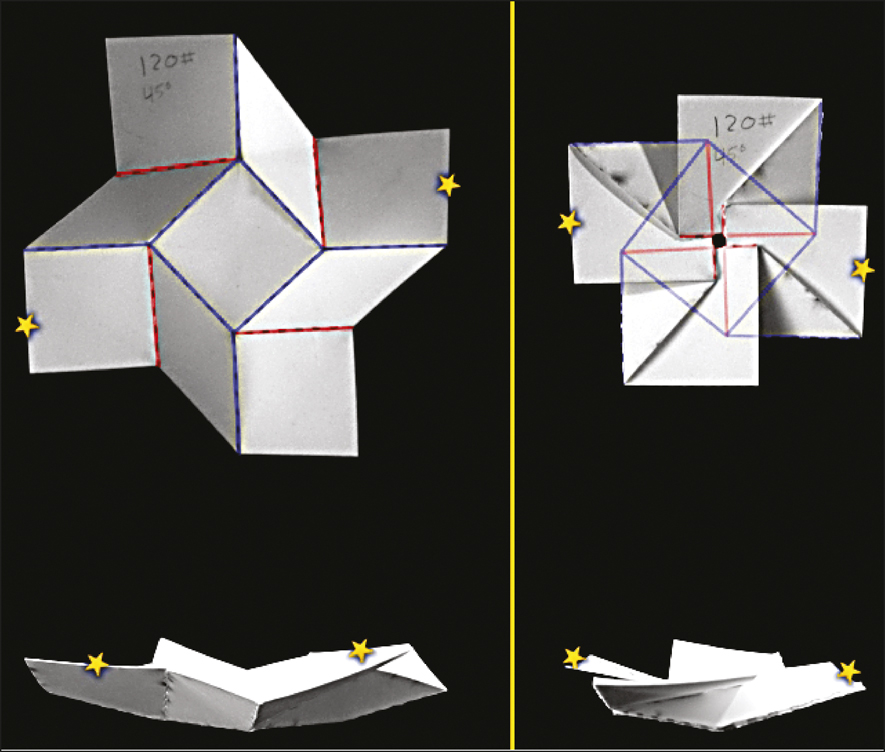Origami, the art of paper folding without cutting, emerged centuries ago in Japan, and the practice still flourishes today. This whimsical form of sculpture, however, is not just the domain of school children and contemporary artists, but also of mathematicians, materials scientists, and physicists. Beginning in the 1980s, researchers realized that the techniques and rules that govern origami could also be used to explore and solve scientific problems such as tuning fundamental properties of thin sheets or creating programmable materials. Now, a microscale machine with a toggle switch joins the ranks of origami creations, as described in a recent issue of Nature Materials.
The folding pattern behind the design, called a square twist, is composed of squares and parallelograms whose toggle-action strength is controlled by the angles between its creases. When open, the structure is fully extended and flat, and when closed, it features a small pocket. The design could eventually be used to engineer switches that are activated under a range of different conditions.
“We’ve created mechanical switches that are smaller than a speck of dust,” says Itai Cohen, a professor of physics at Cornell University. “The device also demonstrates the ability to translate geometric principles from the macroscale to microscopic levels.”
The mechanical switch, he continues, exemplifies the fact that relaxing certain theoretical rules that govern idealized models can better reflect real-world conditions. In this case, an idealized model would assume that the square twist’s facets—the panels bounded by the folds—are completely rigid, with zero degrees of freedom, therefore making the overall structure unfoldable. In reality, however, the paper’s facets regularly bend, giving it a range of behaviors that would not be predicted if those hidden degrees of freedom were not taken into account. As Cohen says, “This relaxing of the rules will be important for many other folding patterns and for metamaterials in general.”

The square twist origami pattern before folding (left) and after folding (right). The red and blue lines show which direction creases fold, with blue being valley-like and red being mountain-like, while the stars are reference marks showing the same points in all pictures. Credit: Jesse L. Silverberg, Jun-Hee Na, Arthur A. Evans, Bin Liu, Thomas Hull, Chris D. Santangelo, Robert J. Lang, Ryan C. Hayward, and Itai Cohen.
Cohen and his colleagues began by investigating the square twist the old-fashioned way—in paper. They folded the laser-cut paper structure by hand, and then attached pieces of tape to its sides. They used a force transducer to measure the energy needed to pull the device open, and also to map the stable and unstable states associated with that process. They found that tuning the degree of bending in the facets allowed them to create structures that varied between having a very strong on/off switch, to ones with smooth opening and closing actions that lacked any abrupt transition between the open and closed states.
The researchers also tested the device using microscopic self-folding polymer gel sheets, designed by colleagues at the University of Massachusetts Amherst. Different temperatures, they found, produced variable opening and closing responses depending on the size of the submillimeter scale device.
“Formalizing the rules of origami for use in computer modeling and simulation has been challenging because theoretical models tend to be oversimplified, often erroneously classifying a foldable origami structure as unfoldable,” says Markus Buehler, a materials scientist and engineer at the Massachusetts Institute of Technology, who was not involved in the work. “The work reported here makes an important contribution to overcoming these shortcomings.”
As Cohen and his colleagues reported, they combined the paper and gel trails’ results to issue a generic design principle for the structure, which should work for any folded sheet. This could include strings of devices whose mechanical switches open to release their payloads under various conditions, for example, or microscopic robot grippers.


